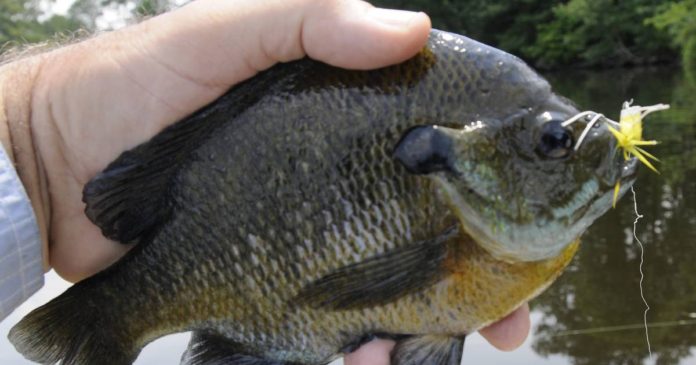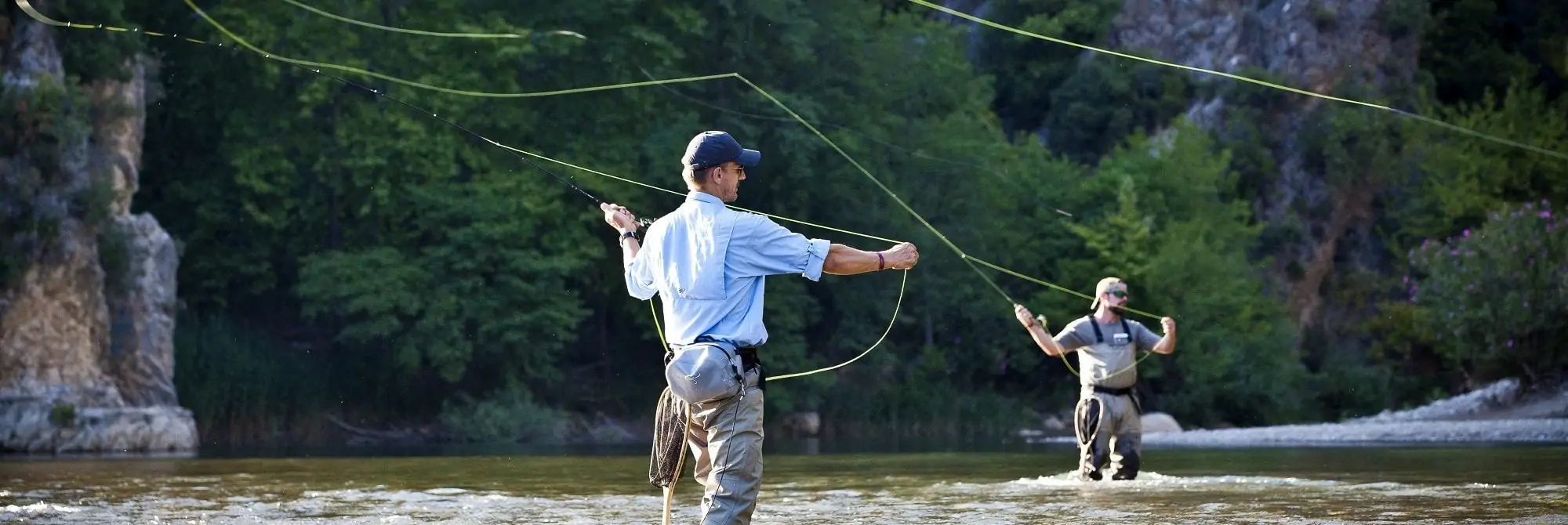Bluegill fishing is another rite of spring along with shad and shallow water bass fishing. This is easy fishing that provides lots of action with fly or spinning tackle. It’s also a great opportunity for kids and beginners.
Bluegills are widely available. Like most fishermen, I’m including shellcrackers, various sunfish and even rock bass under the bluegill umbrella. Some of my favorite waters are Piney Run Lake, Cunningham Falls Lake, Liberty Reservoir, southern Delaware ponds and the Upper Potomac River. Private ponds can be good, too, if you can get access. Fishing can be available from shore, or by boat, canoe, kayak or float tube. Tackle required is minimal and basic.
Bluegill bugging is the classic method. The best tackle is standard trout tackle — an 8- to 9-foot, 5- or 6-weight rod, matching floating line and a 9–foot leader tapered to 3X.
I like foam bluegill Gurglers, poppers and spiders with rubber legs. Cork poppers and slider work, too. Most commercial bugs have long legs, but I cut them back a bit, since often small bluegills will grab the legs instead of the bug body and hook. Size 10 is the standard, but I recommend carrying a few size 8 bugs. The small bluegills often can’t inhale the larger bugs but bigger bluegills — and bass — can. I once had a banner day fishing on a Delaware pond with Walt Knapp, and we each took dozens of bluegills in a couple of hours of steady fishing. But Walt fished the larger bugs and took five bass to none for me, plus one of his bluegills registered 1¼ pounds on the Boga Grip.
In spring, bluegills can be spotted up near the shoreline often under overhanging trees or near shoreline fallen trees. Later, during the spring spawning time, you’ll see dozens and dozens of round, light-colored beds, several feet in diameter, the bluegills swept clean in preparation for spawning. Bluegills will be hovering over or near these beds. These are your targets.
The technique is simply to gently cast to these spots. You don’t need to pop your bug or give it a lot of action, just an occasional twitch. Bluegills come boiling up from the bottom and inhale the bug, often with a kissing sound. The strike is similar to that of trout fishing — a gentle tug on the line hand and slight lifting of the rod. Often, the fish hook themselves.
Subsurface flies work, too, and often work better when bluegills aren’t on the beds. A lot of small wet flies, trout jigs and streamer will work, but there’s one that’s hard to beat, a size 10 beadhead or lightly weighted, black wooly bugger. With any of these patterns, just cast it to a likely spot, let it sink a bit, then slowly retrieve.
A wide variety of spin tackle will work and can be used in places where there’s no room for fly casting. Specialists prefer ultra light tackle with 4-pound monofilament. Rods are typically 5- to 6-feet long, with specialty rods 10-feet or longer. One can fish the smallest versions, 1½ inches or less, of such lures as Teeny Torpedoes, Rebels and Pop-Rs. But the lure of choice is a 1/32 to 1/16th-ounce jig, maybe tipped with a bit of plastic or natural worm or grub. Some of these can be cast alone with ultra light tackle but most will require a float for casting weight.
But with ultra light and any standard light to medium spin tackle and 6- to 8-pound monofilament the above jigs and flies can be used with a float. Again, this is a great method for kids and beginners and provides the same visual appeal of the fish hitting a floating bug as with fly fishing or watching the float dance and sink.
I recommend a small, oval, clip-on float in clear plastic. Use the smallest size your rig can cast. Simply tie on a bluegill bug or sinking fly or lure, and clip on the float about 2 feet above it. If the fish are deeper than a couple of feet you could use a slip float for sinking lures. The float supplies the casting weight.
Carroll County Daily Headlines
Daily
Get the day’s top news and sports headlines.
Try to smoothly swing the cast to avoid the rig going out with a helicopter motion. This is particularly critical when casting under trees or near snags. After the cast hits the water reel in so there is no slack between the float and a floating bug. Again, work a floating bug with just a few twitches. Sinking lures may be fished with slow reeling with pauses. Set the hook quickly but not violently with float rigs.
With any of the above tackle you can expect a few bonus fish such as bass, crappie, perch or pickerel depending on the water.
:quality(70)/cloudfront-us-east-1.images.arcpublishing.com/tronc/3FDR2MFXGZBYJFJO5XSY4NARQ4.jpg)
Years ago, Joe Bruce and I regularly fly fished bluegill bugs on Piney Run Lake with great success. Frequently I observed big bass chasing after the bluegills we hooked. So I began carrying a casting rod loaded with a spinner bait when fishing from a boat. I caught some 3- and 4-pound largemouths we had turned on with our bluegills.
Bluegills will gobble down small pieces of worm or grubs fished below a small float on a size 8 or 10 hook with a small split shot a few inches above. But scented artificial baits and flies and lures above can be just as effective and avoid the “ick” factor.
When I first took my grandson bluegill fishing, he struck too slowly with jigs and with worms. Small scented artificial grubs and worms drew plenty of strikes and were tough enough to stay on the hook long enough for him to set the hook.
Releasing bluegills takes some thought. Bluegills have relatively small mouths and sometimes inhale a fly, lure or bait, another argument for larger hooks. File away or mash down the barbs on all hooks beforehand. Keep the fish in the water then use bent-nosed forceps to grasp the hook shank to gently extract the hook.
Bluegills are tasty and most waters benefit for removing some. Most kids like sampling their catch.
Credit: Source link































